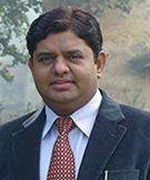 Dr. N. S. Rajput (Telecommunications)
Associate Professor in Electronics Engineering IIT (BHU), Varanasi |
nsrajput.ece@iitbhu.ac.in |
The fourth industrial revolution is around the corner. So far, information technology had been the primary thrust/application, and all industrial and societal processes have been put on network. Much real-time and off-line data are being gathered. ‘Trillion sensors and actuators’ in any walk of life is the new paradigm. Computation and analytics are now the key for controlling physical systems and assured sensing and actuation is the new challenge. With such challenges, current networks that are based on best-delivery-efforts will no more be suitable. Even, we cannot afford to miss any single bit of information at the sensor side or the signal which has been sent to any single actuator. Each bit is essential and any mistake is unacceptable. Accordingly, whole new sets of new networking protocols with guaranteed-delivery of services will be needed. In the Cyber Physical System paradigm, it will require innovative approaches for the air interface providing massive scale transport over TCP – Ethernet IP and Time Sensitive Networks (TSN).
There is need for ultra-low latency, both in packet transfer and computation, leading to hybridisation of computer hardware with virtualised software based computation on the network interfaces, supporting massive ‘softwarization’, converging to IT methods and supporting absolute convergence of sensing and actuation well in tune with the data analytics and predictive technologies to impart intelligent automation. We are at the threshold of a new revolution desiring holistic innovations and inventions to deliver such high-performance requirements. The proposed TIH for mounting a national mission on data analytics and predictive technologies (NM-DAPT) will lead India to produce innovations, inventions and new technology developments in the area of Intelligent Networks and Communication Systems, seeking state-of- the-art delivery of teaching, learning and manpower skilling, all across the globe, to design, deploy and run products and technologies for seamless adoption of DAPT.